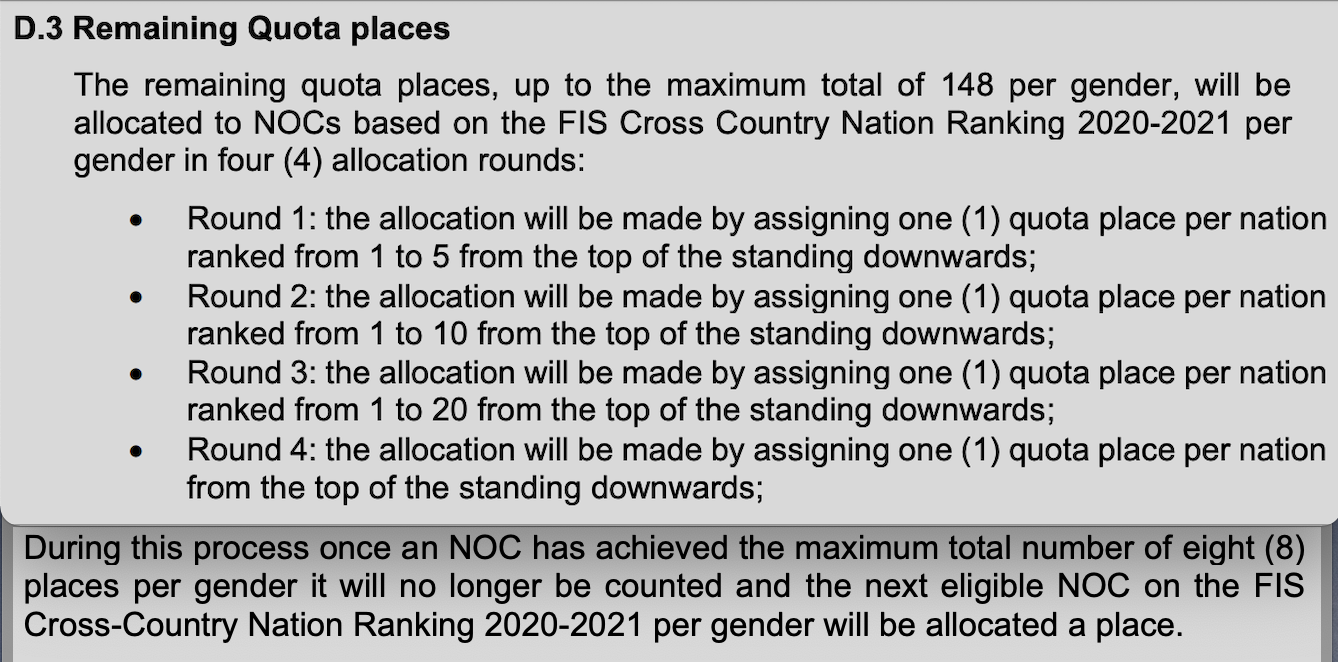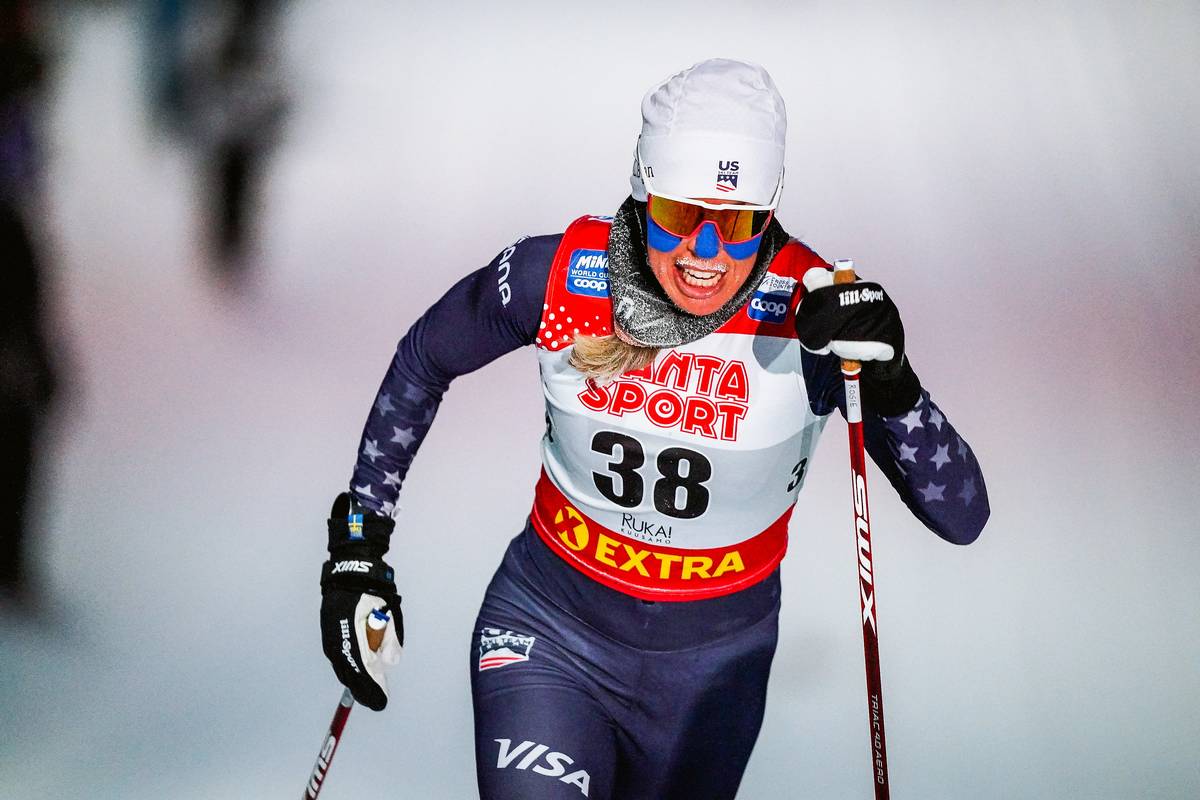
It’s always tough to make the Olympic team. It got tougher this year, due to smaller quotas for all nations interacting with some math that is disadvantageous to the American men.
If you just want the executive summary of this article, here it is: The maximum team size, for any nation’s nordic team for the 2022 Olympic Winter Games, is eight athletes per gender. If the Games started tomorrow, the Americans would be able to send a total of eight women to Beijing, up to five of them sprinters. They would only be able to send five men, no more than four of them sprinters; it seems likely, but not guaranteed, that the latter figure will soon increase to six men total, with the same four-sprinter maximum. The eight-athlete quota for the American women will not decrease.
You would be justified in closing this tab now and heading off to start drafting form charts for the American Olympic squad and arguments for your favorite athletes. If you’d like an explanation behind the math, a brief history lesson, and/or some parameters for your speculation, then read on.
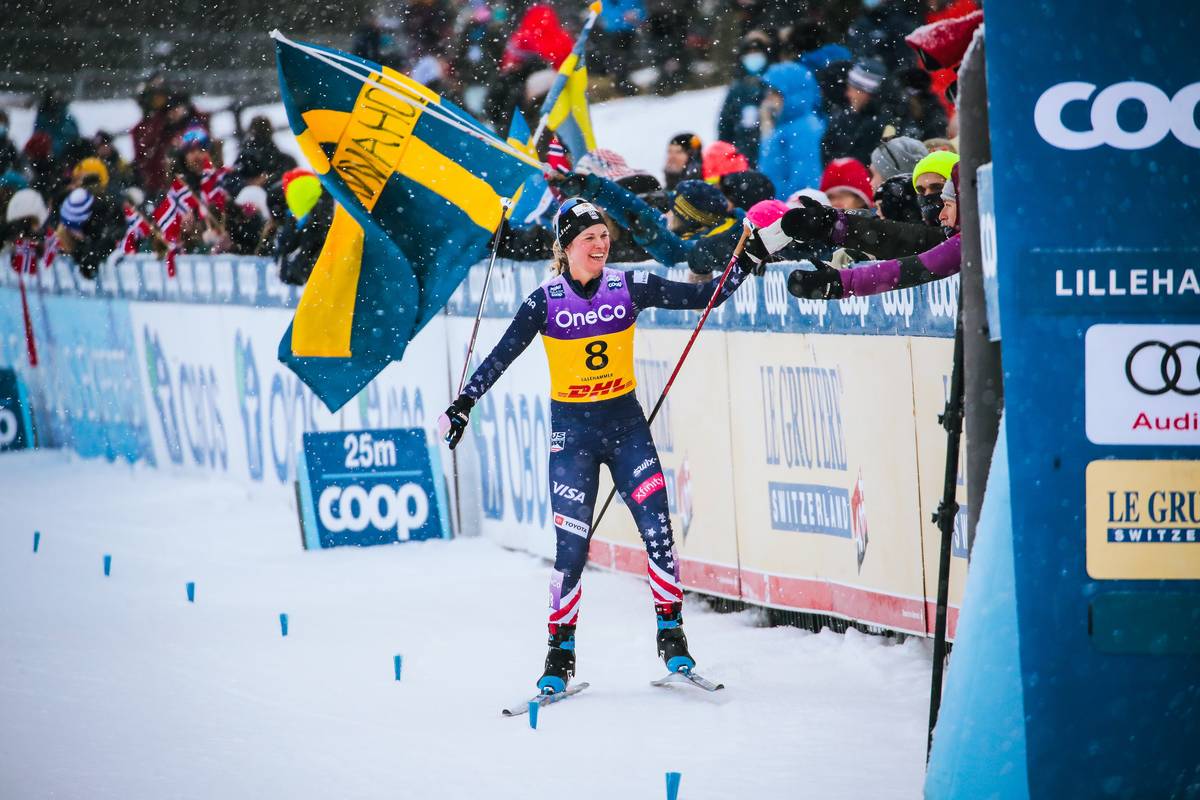
The quota system: Theory and practice
The system under which different nations may send different numbers of cross-country athletes to the 2022 Olympics is controlled by a dense, but logical, document promulgated by FIS, which may be found here. It has been interpreted in graphical form in this somewhat more user-friendly Wikipedia article.
Briefly put, the qualification system assigns one quota spot to any nation with at least one athlete racing at least year’s World Champs who met a minimum standard of international competitiveness. It then assigns the next tranche of quota spots in a manner consistent with how well a nation’s athletes did on the World Cup last year. Finally, remaining quota spots are allocated, in an iterative distribution, in a manner that similarly rewards nations with better performance in last year’s World Cup season.
The process proceeds independently for each gender, even within the same country, which is why the American women currently have the full eight spots, and the American men only five: The women ranked higher than the men in last year’s World Cup standings, which inures to their benefit in this year’s Olympic quota “standings.”
Step one: Each nation (or, most precisely, each National Olympic Committee, or NOC) that had at least one athlete notch a result below a specified FIS-point cutoff in at least one race at 2021 World Championships or U23 Championships gets one quota spot for this year’s Olympics. This standard is 300 FIS points, for men, or 330 FIS points, for women.
As a reminder, lower FIS scores indicate a more competitive race, and the lower an athlete’s FIS points the better their ranking relative to another athlete. For example, Jessie Diggins scored 8.17 FIS points for her second-place finish in the 10k skate in Davos, while winner Therese Johaug (NOR) scored 0.0.
Going back to the 300/330 standard, this is not a particularly rigorous standard to meet; this reporter could likely have obtained a result worth less than 300 points at the 2021 World Championships.* At the December 5th SuperTour in Duluth, MN, all but two athletes in the men’s 10k skate race earned fewer than 300 FIS points, despite finishing as much as +8:36 behind winner Zak Ketterson. The two athletes who earned over 300 points hailed from Israel and Venezuela, and were born in the 1970s; each finished more than 20 minutes behind the winner.
With that perspective, each of the professional athletes on the U.S. Ski Team has more than met this standard, to put it mildly. Log one quota spot each for the American men and women.
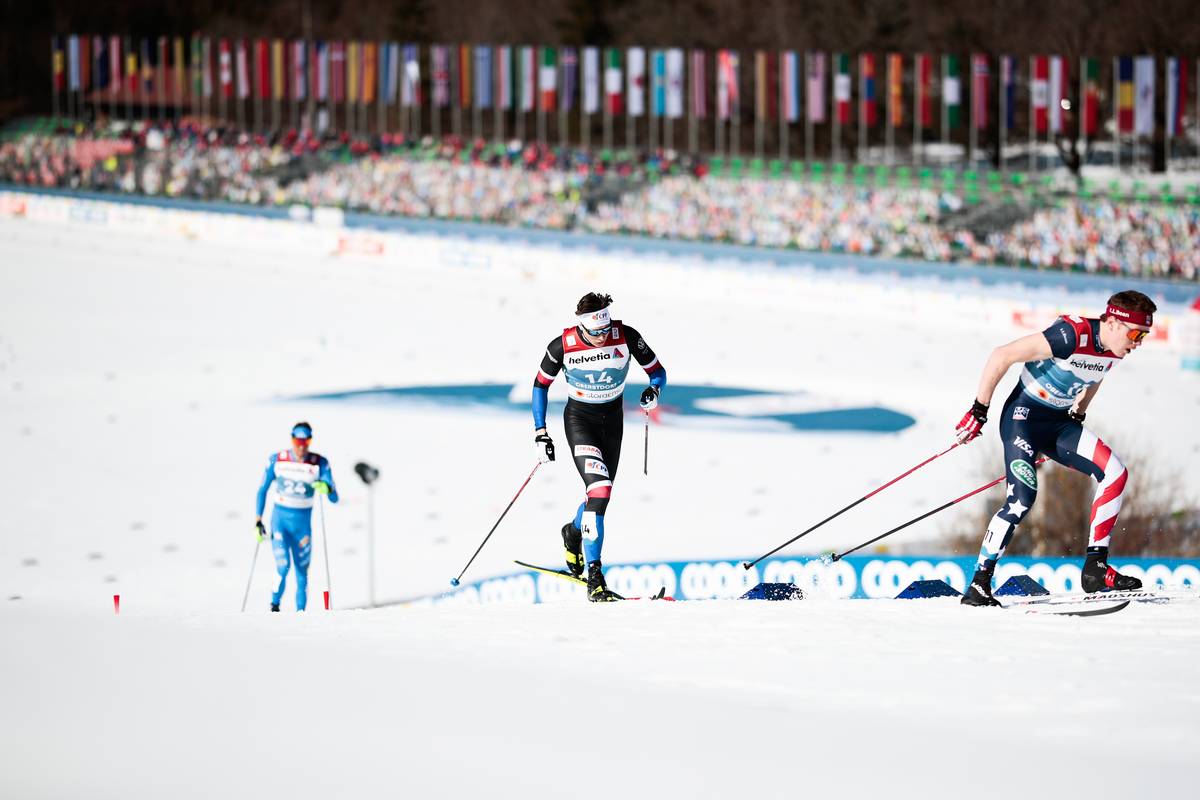
Step two: Each country gets an additional number of quota spots based on where its athletes ranked for their cumulative overall performance in last year’s World Cup (“Nation Ranking for OWG”). The American women were third in these standings last year; the American men were ninth.
Nations ranked 1–5 on this list get an additional four quota spots in step two; nations ranked 6–10 get three. So that’s now up to five spots for the women (1 + 4), and four for the men (1 + 3).
(Also in step two, nations ranked 11–20 get two quota spots, then nations ranked 21–30 for men, and 21–33 for women, get one quota spot.)
Step three: Now it gets slightly complicated. Take those spots previously allocated in steps one and two. Subtract that from the total of 148 quota spots per gender (less a guaranteed minimum of four per gender for the host country, China, as necessary). Allocate the remainder according to the following metric (screenshot from FIS quota document):
So, for example, the third-ranked American women got one quota spot in Round 1 (up to six total), then another in Round 2 (seven total), and another in Round 3 (eight total, the maximum possible).
The men were ranked ninth, so they got nothing in Round 1. They received an additional quota spot in Round 2, bringing them up to five total (1 + 3 + 1). And that’s… all for the time being. If the Olympics started tomorrow, the American women would have eight quota spots, and the American men would have five. Sorry, 165 out of 170 Olympics-eligible American men.
Step four: Not all nations fill all their start spots. The Americans in 2014 are one example of this, as discussed in the history section below. If a nation declines to fill all its quota spots, or wants to but is unable to do so with qualifying athletes (e.g., an athlete has more than 300 FIS points on the January 17, 2022, distance list, or incurs an anti-doping violation), then unused quota places will be reallocated to the next eligible nations, in accordance with the distribution list at the bottom of this page. The American men are currently first in line to receive the next spot that becomes available in the reallocation process. If substantial reshuffling occurs, the American men also have spot no. 16 on the reallocation list, which would bring them up to seven quota spots total.
Timing: FIS informs National Olympic Committees of their final quota numbers on January 17. NOCs must confirm how many allocated quota places they will use on January 17 or 18.
Over the next two days, January 19 and 20, a certain amount of expedient reshuffling occurs: “FIS to reallocate all unused quota places and NOCs to confirm within 12 hours,” the FIS quota document states.
Entries are due to Olympic race organizers on January 24. The first cross-country race at this year’s Olympics is the women’s skiathlon on February 5.
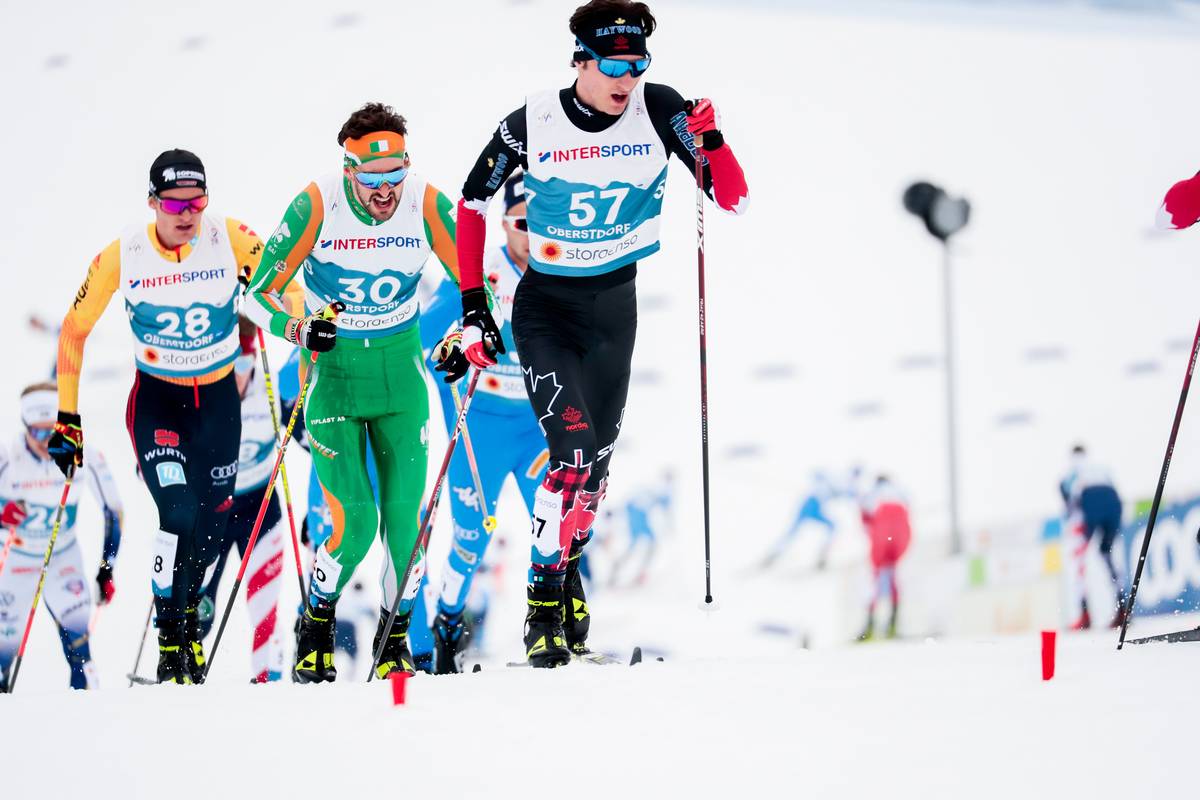
What about Canada?
Our neighbours to the east, if you live in Alaska, or to the north, if you live in the Lower 48, currently have four quota spots for women and three for men. They are currently in sixth position on the reallocation list, for the women, and fourth, for the men, for any new spots that become available. Canadian ski fans will be hoping to receive at least a quota spot for a fourth male athlete in Beijing so that they can field a relay team.
Some historical comparisons
The baseline quota size, and the number of athletes the U.S. Ski Team has taken relative to this quota, have varied over the years. Across the last three Olympiads, for example:
- In 2018 (Pyeongchang), the American nordic team had a total quota of 20 athletes. They filled this quota, taking nine men and 11 women.
- In 2014 (Sochi), the quota was 17 athletes. The U.S. Ski Team did not fill this quota, instead taking seven men and seven women, citing visa restrictions that limited the amount of staff available and a desire to take only competitive athletes to the Olympics. The Americans’ three unused quota spots were reallocated to other nations.
- In 2010 (Whistler), the American quota was initially seven athletes at the start of the 2009/2010 World Cup season, but was later expanded to eight, then ten, and ultimately to 11 athletes in the months leading up to the Olympics. A 22-year-old sprinter named Simi Hamilton was the 11th and final American athlete taken.

Team naming tends to evoke impassioned responses within the relatively insular American nordic skiing community, where many fans of the sport have a direct connection to athletes who were or were not named to the team, and where Olympian status is often widely valued above all else.
Ask supporters of, say, Eric Packer their thoughts on his not being named to the team in 2018, arguably due to Annie Hart being named instead. However, a spot on a team does not guarantee starting in an Olympic event. As Hart was selected as a sprinter on one of the world’s deepest sprint teams, she attended the first few days of the Pyeongchang Games, then flew home without starting any of the races. Meanwhile, the American men started two athletes primarily known as sprinters, Andy Newell and Reese Hanneman, in the 4 x 10-kilometer relay, and a third, Tyler Kornfield, in the 15 k and 50 k.
Or ask supporters of Sylvan Ellefson/Matt Liebsch/Caitlin Gregg/Kate Fitzgerald/take your pick if they think “their” athlete should have filled one of those last three spots in Sochi instead of being left home. They’ll probably have thoughts on this. Indeed, the 31 reader comments preserved on the bottom of this 2014 FasterSkier article give a sense for the depth of this sentiment among American ski fans.

Some guidelines for speculation
Step one of team naming, discussed at length above, is how many spots are available to fill. Step two, previewed here, is which athletes are taken to fill those spots, and what criteria are used to choose them.
With regard to step two, the first version of the U.S. Olympic team will not be named until January 17 or 18, 2022, and is potentially subject to revision depending on results of the reallocation process, so take this entire section with a grain of salt. Also keep in mind that there are multiple World Cup races yet to come.
Nonetheless it is possible to say, with reference to the selection criteria, that if the American Olympic team were named as of Monday of this week (December 27, one day before the start of the Tour de Ski), Rosie Brennan and Jessie Diggins would certainly be on it: Both have met the objective standard of qualification via a top-8 result in specified races. Julia Kern, Hailey Swirbul, Hannah Halvorsen, and Sophia Laukli would likely be on the team, for the women, and JC Schoonmaker, Ben Ogden, Kevin Bolger, Luke Jager, and Gus Schumacher, for the men: All are currently* (*as of December 27, before the Tour de Ski races began) in the top-50 sprint or distance World Cup standings, under a slightly modified USSS scoring list that discards points earned in relays, team sprints, or Dresden in accordance with the “excluded points” language of the criteria document.
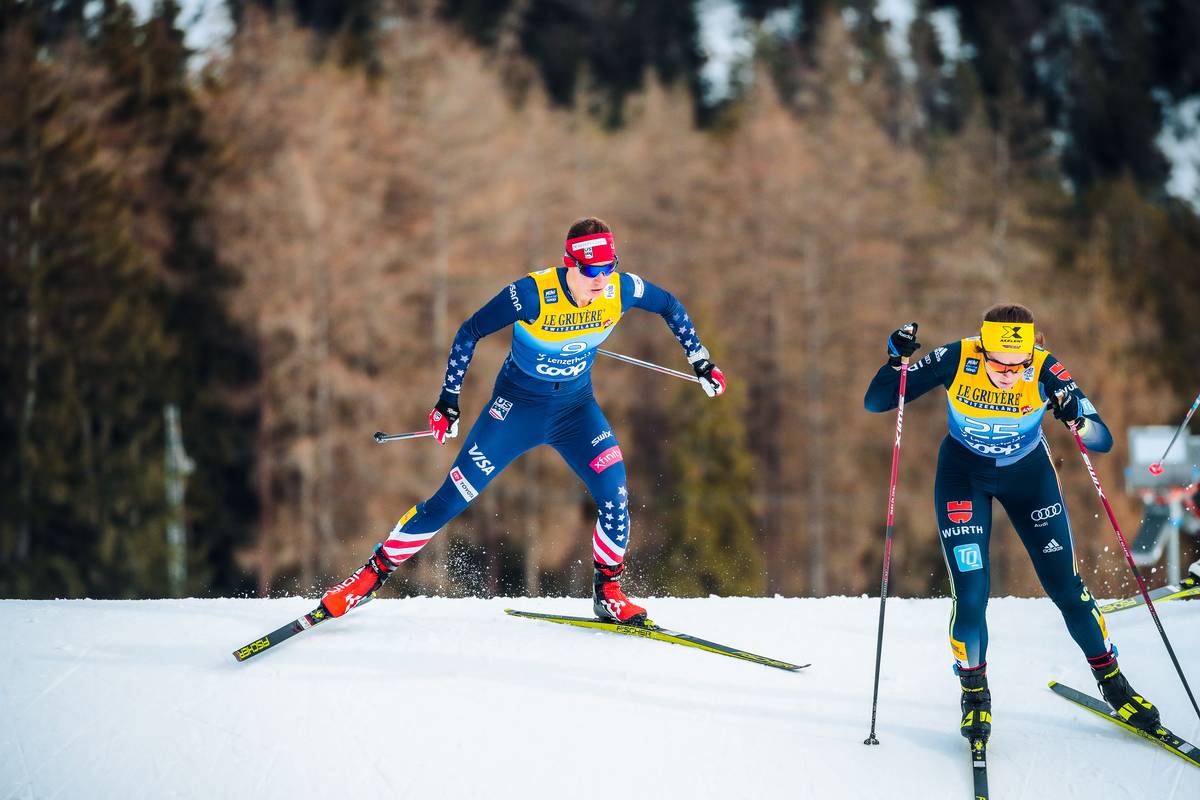
Again, these standings are very much subject to change between now and January 17; this is just a snapshot from the start of this week. [One update: For example, Kern met the objective qualification standard with her fourth-place finish in Tuesday’s skate sprint in Lenzerheide.] There will be three scoring distance races during the Tour de Ski (the final climb does not count), and two more at the January World Cup weekend in Les Rousses, France, before Olympic selections are made. Plus some sprints. Not all athletes will contest all races. These things are definitely subject to change.
High-performing athletes from next week’s U.S. Nationals races, and other athletes not otherwise captured by the criteria, may also be named to the team, depending upon overall team size, quota spots available, and the exercise of discretion. Domestic athletes relying on their performance at U.S. Nationals for potential team naming are on the bottom of the totem pole for Olympic selection, in the sense that this selection method is number four out of four, and comes into play only “Should there be any remaining quota slot(s) after Selection Methods Nos. 1-3 above have been applied … .”
Turning to the Olympic races themselves, which could bear on the makeup for discretionary selections to fill any remaining quota spots, there are three pure distance events in Beijing: the 10/15 k interval-start classic, the 15/30 k mass start skiathlon, and the 30/50 k mass start freestyle. There is one pure sprint event, the, well, skate sprint.
The classic team sprint has “sprint” in its name, but it is seeded based on either an athlete’s sprint or distance points, depending on which is better. This seems telling, and U.S. global championship medalists in this event include the skilled generalists Diggins and Sadie Maubet Bjornsen, plus late-career Kikkan Randall was a top-10 World Cup distance skier, so, ¯\_(ツ)_/¯.
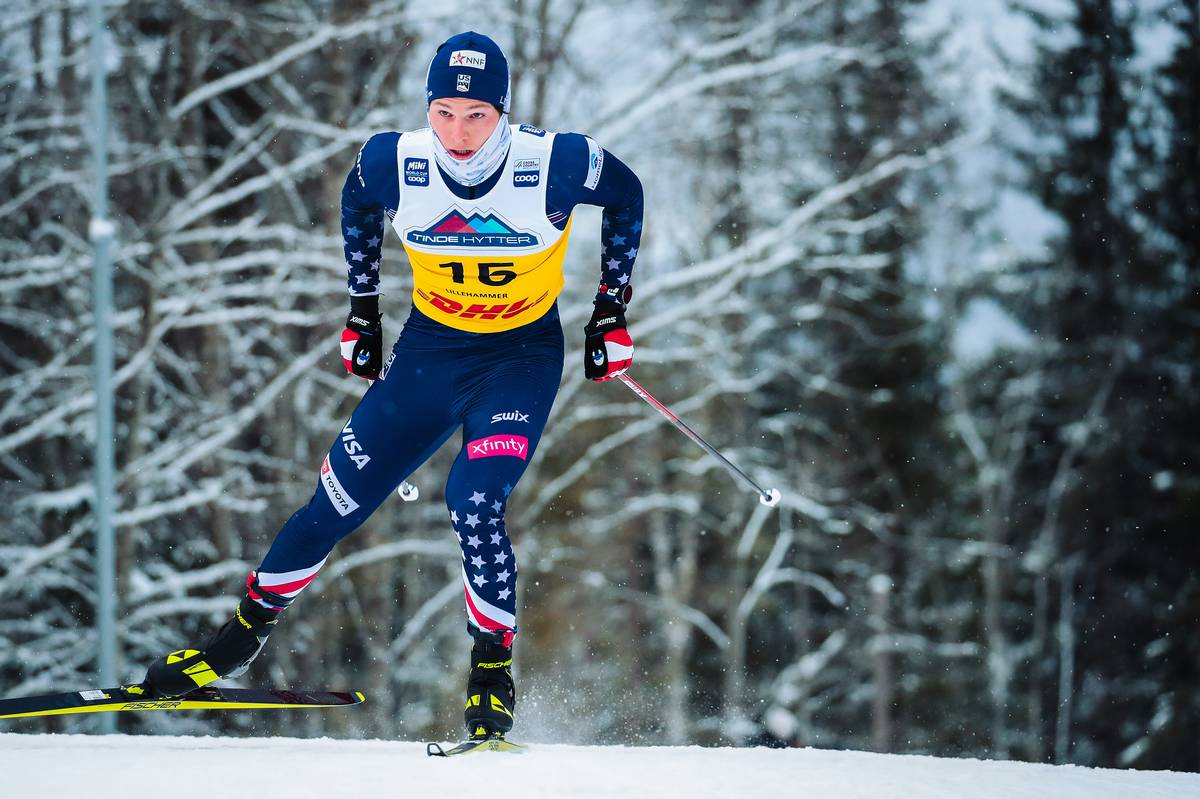
The men’s relay, 4 x 10 k, certainly feels like a distance event, but the women’s relay is only 4 x 5 k, so maybe it’s a little less so. But putting a pure sprinter on the scramble leg in Pyeongchang didn’t lead to a medal on the day (though it still was the American women’s best Olympic finish in the relay), so maybe it’s a distance event after all? But maybe also the U.S. men are stronger in sprint than in distance right now, as witness the four athletes listed above who would qualify off of the sprint rankings (Schoonmaker, Ogden, Bolger, and Jager), versus only one for distance (Schumacher), so it looks like there’s going to be some “sprinters” on that men’s relay team regardless of how you classify it?
Bottom line, the U.S. has four start spots per race, six races over two weeks, a total of 24 start spots per gender. Bringing eight women, and assuming for the moment equal distribution, yields three starts per athlete. (This ignores the fact that someone like Diggins could, and likely will, start all six races and be a contender in each.) Bringing six men, mutatis mutandis, yields four starts per athlete, which is a higher workload.
The American women’s best distance skiers, Brennan and Diggins, are currently also their best sprinters. There may be less overlap for the men, though with an exquisitely young team athletes’ strengths are still being refined from week to week as their cumulative World Cup experience swiftly accrues. Do you strive for four starters in every race, across all races and genders, or do you aim to maximize your chances of medaling by putting more contenders in fewer races, potentially leaving some start spots unfilled as athletes tire over a high-stress two-week race period. You have only six athletes to pull this off for the men, maybe as few as five, and most of them may be only 21 years old. Start your speculation now.
Related reading:
U.S. Ski & Snowboard 2022 Olympic Winter Games selection criteria
Qualification system for XXIV Olympic Winter Games, Beijing 2022, cross-country skiing
Qualifying for the Olympics is hard. So is keeping it a secret. (Nat Herz, Anchorage Daily News, February 2018)
The Cross-Country Olympic Criteria, in the Context of U.S. Winter Sports (FasterSkier, June 2017)
The Other Side of U.S. Nordic Olympic Team Naming: Decisions, Emotions and Everything in Between (FasterSkier, January 2014)
* This isn’t just a throwaway remark. I’m typically around 25% back from World Cup skier Scott Patterson in local skate races. 25 percent back from Patterson in the 15 k skate in Oberstdorf would have yielded a time of 45:13.4 – dead last, unsurprisingly for a random 39-year-old in a global championship race, but also good for 270 FIS points. My point is not that I’m a particularly good skier – I’m not; ask me about fighting to avoid DFL in local Junior Nationals qualifying races – but rather that this is not a particularly stringent standard relative to what is generally viewed as the pinnacle of human athletic achievement.
For comparison’s sake, the infamous Dominican Olympic nordic skiers Gary di Silvestri and Angelica Morrone likewise notched sub–300 FIS point results in the run-up to the 2014 Olympics. Their ski results in Sochi were treated here; their coach, J.D. Downing, shared his side of the story here. Neither athlete finished a race in Sochi.
Gavin Kentch
Gavin Kentch wrote for FasterSkier from 2016–2022. He has a cat named Marit.

